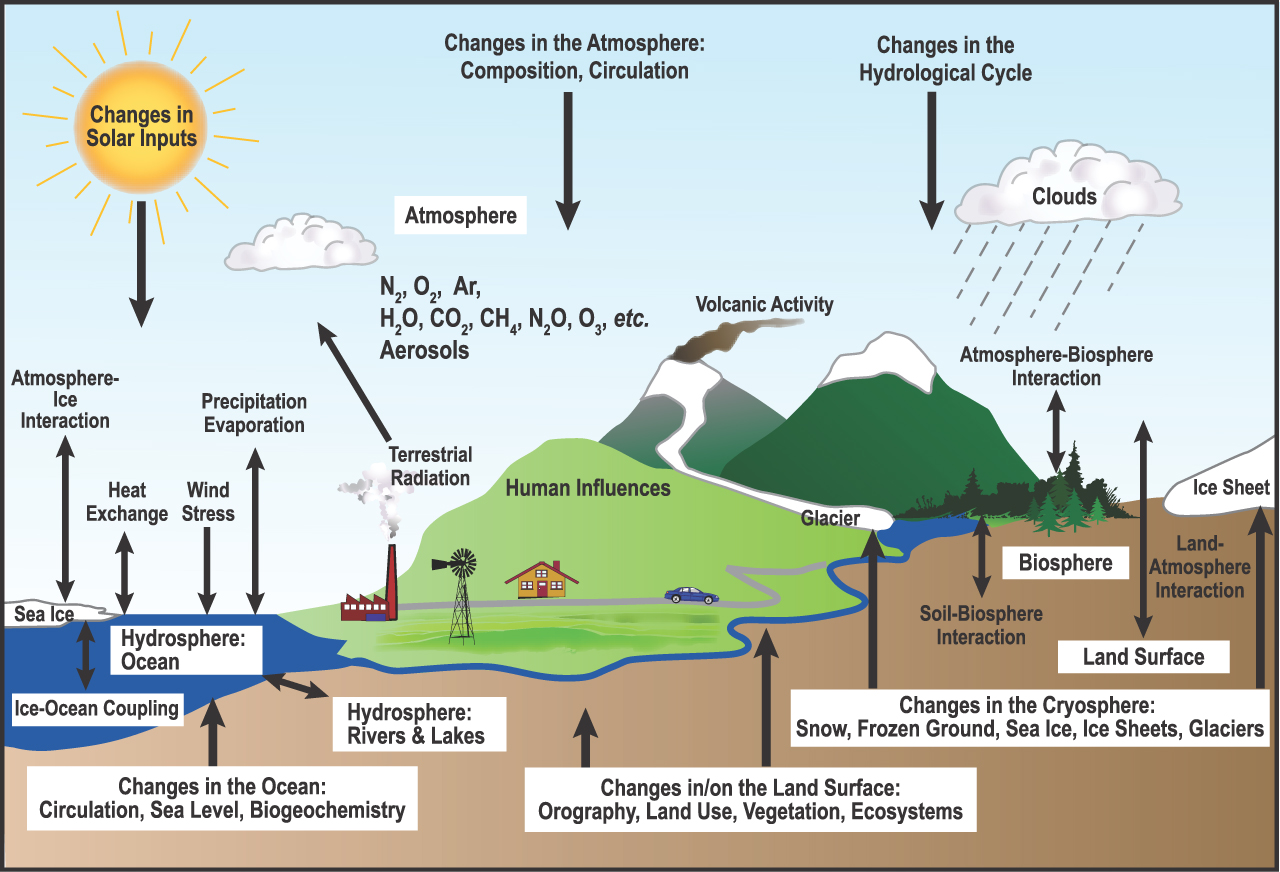
Schematic view of the components of the global climate system, their processes and interactions and some aspects that may change. This information is presented in a series of lists
Components of the Global Climate System
-
Atmosphere (N2, O2, Ar, H2O, CO2, CH4, N2O, O3, aerosols, etc.)
-
Processes and Interactions
-
Atmosphere-Ice Interaction (between the atmosphere and the Sea Ice)
-
Heat Exchange (between atmosphere and ocean)
-
Wind Stress (from atmosphere to the ocean)
-
Precipitation Evaporation (between the atmosphere and the ocean)
-
Terrestrial Radiation (from Human Influences to the Atmosphere)
-
Atmosphere-Biosphere Interaction (between the atmosphere and the biosphere)
-
Land-Atmosphere Interaction (between the Land and the atmosphere)
-
-
Aspects that may change in the atmosphere
-
Composition
-
Circulation
-
Solar Inputs
-
-
-
Biosphere
-
Processes and Interactions
-
Atmosphere-Biosphere interaction (between the atmosphere and the biosphere)
-
Soil - Biosphere Interaction
-
-
-
Land Surface
-
Processes and Interactions
-
Land - Atmosphere Interaction (between the land and the atmosphere)
-
-
Changes in/on the Land Surface
-
Orography
-
Land Use
-
Vegetation
-
Ecosystems
-
-
-
Cryosphere: Sea Ice, Ice Sheets, Glaciers
-
Hydrosphere: Rivers and lakes
-
Processes and Interactions
-
between the Hydrosphere: Rivers and Lakes and the Hydrosphere: Ocean
-
-
-
Hydrosphere: Ocean
-
Processes and Interactions
-
Atmosphere-Ice Interaction (between the atmosphere and the Sea Ice)
-
Heat Exchange (between atmosphere and ocean)
-
Wind Stress (from atmosphere to the ocean)
-
Precipitation Evaporation (between the atmosphere and the ocean)
-
Ice-Ocean Coupling (between the sea ice and the ocean)
-
Hydrosphere: Ocean and Hydrosphere: Rivers and Lakes
-
-
-
Aspects that may change in the Ocean
-
Circulation
-
Sea Level
-
Biogeochemistry
-
-
Human Influences
-
Processes and Interactions
-
Terrestrial Radiation (from Human Influences to the atmosphere)
-
-
The climate system is comprised of five natural components:
- the atmosphere - the envelope of gases that surrounds Earth, including the naturally occurring greenhouse gases that warm the planet’s surface
- the hydrosphere - includes all of Earth’s liquid water and gaseous water (water vapor), whereas the cryosphere includes all frozen water (ice)
- the cryosphere - technically part of the hydrosphere, but climate scientists usually treat it as a separate component of the climate system because its physical properties differ from those of water and water vapor
- the land surface - (does not include water- or ice-covered surfaces) consists of all other vegetated and non-vegetated surfaces
- the biosphere - the realm of life and is found in all of the other natural components, especially the hydrosphere and land surface. In fact, the biota is made up of and requires the presence of air, water, and mineral matter—that is, material from the atmosphere, hydrosphere, and land––to exist
Several external forces influence the five climate system components, with radiation from the sun being most important. Climate scientists consider the impact of human activities on the climate system another example of external forcing.
